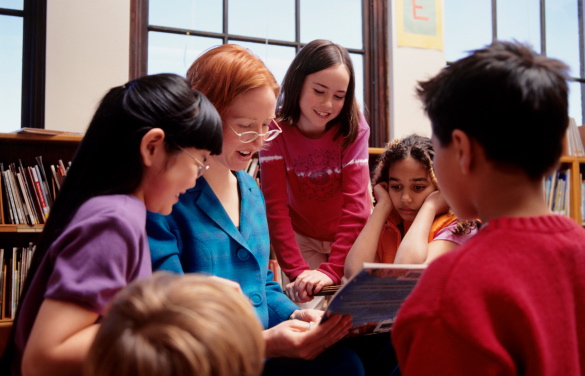Data on Reading Aloud to Older Kids
Why Reading Aloud to Older Children Is Valuable
Failed to save article
Delight effort again

Educator and author Jessica Lahey reads Shakespeare and Dickens aloud to her seventh- and eighth-graders, consummate with all the voices. Her students love beingness read to, and sometimes become so carried abroad with the story, she allows them to lie on the floor and close their optics only to listen and enjoy it. Lahey reads short stories aloud, as well: "My favorite story to read out loud has to be Poe's 'Tell-tale Heart.' I raise the tension and get a little nuts-o as the narrator starts to really become off the rails. So much fun."
While reading Dickens aloud helps students get used to his Victorian literary manner, Lahey said that it's besides an opportunity for her to stop and explicate rhetorical and literary devices they wouldn't go on their own. And they read the Bard's plays together, divvying up the parts, because "that's how they are meant to be experienced."
Reading aloud to older children -- fifty-fifty upward to historic period 14, who can comfortably read to themselves -- has benefits both academic and emotional, says Jim Trelease, who could easily be chosen King of the Read-Aloud. Trelease, a Boston-based journalist, turned his passion for reading aloud to his children into The Read-Aloud Handbook in 1979; it has since been an unequivocal bestseller with sales in the mult-millions, and Trelease is releasing the seventh, and final, edition in June.
Obviously, Trelease firmly believes in the value of reading to kids of all ages.
"The showtime reason to read aloud to older kids is to consider the fact that a child's reading level doesn't catch up to his listening level until well-nigh the 8th grade," said Trelease, referring to a 1984 written report performed by Dr. Thomas One thousand. Sticht showing that kids tin empathize books that are as well hard to decode themselves if they are read aloud. "You have to hear it earlier you can speak it, and you take to speak it earlier you can read it. Reading at this level happens through the ear."
Research nerveless on middle schoolhouse read-alouds showed that 58 percent of teachers read aloud to their students - and nearly 100 percent of reading and special education teachers. And, while heart-school students reported liking read-alouds, little data has been collected on the "extent and nature" of reading aloud to twelve- to fourteen-year-olds.
"Research indicates that motivation, involvement, and engagement are often enhanced when teachers read aloud to middle school students," wrote enquiry authors Lettie K. Albright and Mary Ariail. Teachers surveyed for the study cited modeling every bit their number-i reason for reading aloud.
Trelease acknowledged that modelling the pleasance of reading is important, simply there are more reasons read-alouds work so well -- like "broadening the card."
"Allow'south take a nine-year-old who'southward just finished two solid years of drill and skill, a lot of testing, a lot of piece of work, and they're competent, but they're thinking in terms of reading as a sweat experience," he said. When a teacher reads a good book in a higher place student reading level, he prove students that the good stuff -- the really bang-up books -- are coming downwardly the route, if they stick with it.
"Broadening the carte du jour" becomes fifty-fifty more important if a child has difficulties with reading. According to Wandering Eductators' Dr. Jessica Voigts, who homeschools her daughter Lillie, reading aloud tin make reading more than pleasurable for someone with dyslexia. "Reading together – with her watching the words as I read, and then her reading to me – is a way to exist together, to experience the world, to enjoy a common pleasure. I read to her, almost two-thirds of the fourth dimension, and then she takes over for one-3rd of the fourth dimension. We pass the book back and forth, although we're usually right next to each other," she said.
And though her girl struggles, Voigt admitted she reads to Lillie for more than than just academic benefits. "This is a fourth dimension -- tweens, teens -- when life is full of craziness. This is one way to accept a place of rest, of existence, something to count on each day. Shared words have power, an energy that you can't get from TV, radio, or online," she said.
For Trelease, the ability of shared words is a big reason to keep on reading aloud afterwards children are able to read for themselves. Students might interject questions, comfortably wading into complicated or difficult subjects considering they are happening to the characters in the story, and non to themselves. "Why do you think so many children's stories have orphans as characters? Because every child either worries or fantasizes about being orphaned."
While Trelease maintained that read-alouds can happen through whatsoever device ("Look at all the truckers listening to books on CD," he said), and Lahey reads from a concrete newspaper book, dogeared and scrawled with all her notes in the margins, both emphasized how students retrieve read-alouds with fond memories. Trelease recently received a letter from a retired teacher who reconnected online with former students some 30 years later. She wanted to know the one thing her onetime students remembered about her class.
"Without fail, it was the books she read to them."
Desire to stay in touch on?
Subscribe to receive weekly updates of MindShift stories every Sunday. You'll likewise receive a advisedly curated list of content from teacher-trusted sources.
Thanks for signing up for the newsletter.
garneryouncesomed.blogspot.com
Source: https://www.kqed.org/mindshift/28582/why-reading-aloud-to-older-children-is-valuable
Belum ada Komentar untuk "Data on Reading Aloud to Older Kids"
Posting Komentar